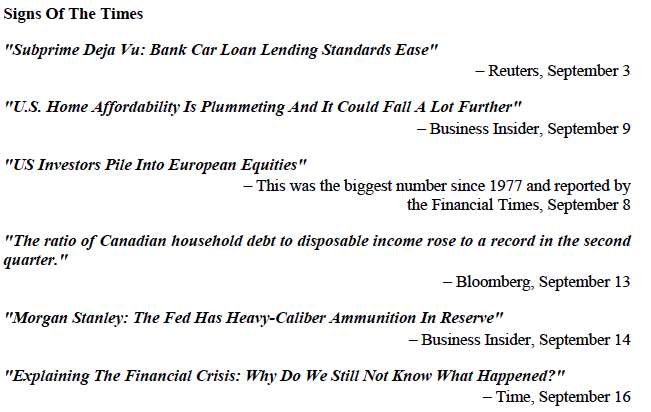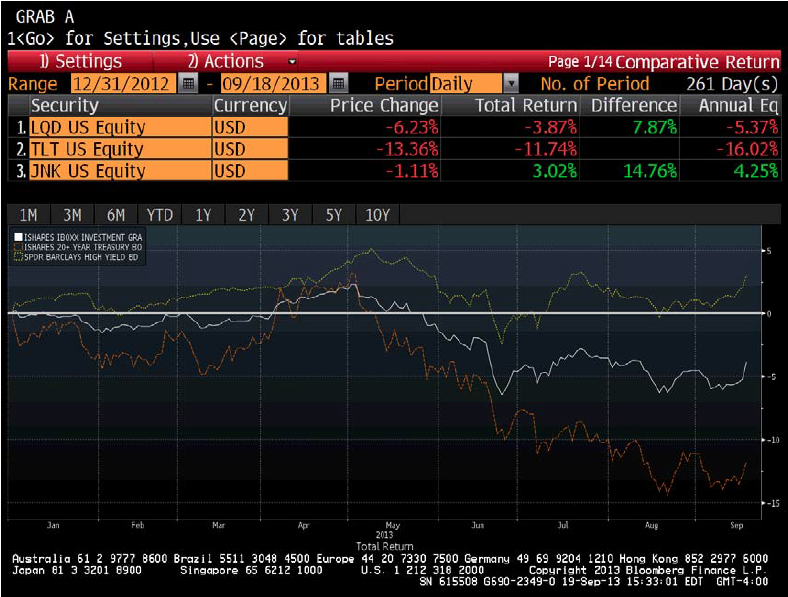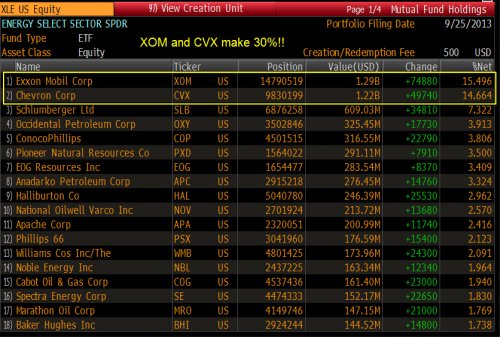Timing & trends
Technically, we now have something quite clear.
INSTITUTIONAL ADVISORS
FRIDAY, SEPTEMBER 27, 2013
BOB HOYE
PUBLISHED BY INSTITUTIONAL ADVISORS
The following is part of Pivotal Events that was
published for our subscribers September 19, 2013.
Overdose of Kool-Aid

The last two quotes show the absurdity of intellectual theories bereft of market history. In 2007 the establishment boasted that with the “Dream Team” at the Fed nothing could go wrong. Now the same establishment that could have anticipated the bust claims not to understand it. And then there is this week’s tout that the Fed still has some “Heavy-Caliber Ammunition”.
If it wasn’t so pathetic it would be disgusting.
The ability of the Fed to get its portion of a credit expansion “out the door” depends upon a big speculative bid from the private sector. Until May the big play was in lower-grade bonds. This is no longer the case, but through the summer stocks and crude oil have been strong. Yesterday, Bernanke announced that the bond-buying program would continue until unemployment met some arbitrary number. In so many words, he renewed his vows to keep trying to depreciate the dollar.
Markets vigorously responded to the Fed in its role as a catalyst.
* * * * *
Stock Markets
Sunshine likely in September has continued with “Benny Bucks” Bernanke providing an almost universal catalyst.
As they saying goes, “When the Fed is the bartender everyone drinks until they fall down”. More than likely it is an overdose of Kool-Aid.
Technically, we now have something quite clear.
The rally from S&P 1627 in late August made it to 1705 on Tuesday. Yesterday’s news popped it to 1726. Overall this is a multi-index spike up with both the DJIA and S&P reaching a limiting level on the Daily RSI.
This year’s strength drove the Weekly RSI to a higher level for a longer time than accomplished going into the 2007 high. And now at 73 the Daily RSI has exceeded the 66 accomplished in October 2007.
The RSI provided negative divergence on that important peak. A loss of momentum now would accomplish just such a divergence.
What also caught our eye was the reversal in Broker Dealers (XBD). Although this is a volatile and at times precarious sector it has been virtually a “one-way-street” since turning around late last year.
This thing does big and long overboughts on the way up. And at the high in 2007 a couple of rallies reached 70 on the Daily RSI.
For this year, the weekly has accomplished the longest run of very overbought in years. It ran from February to May. Since August there has been two thrusts to 70 on the Daily RSI.
Yesterday, Broker-Dealers (XBD) sold off in the morning and jumped from 140.2 to 141.5 on “the news”. This was up on the day, but in only a few minutes it gave it up. At the end of the day it was down almost 1 percent, setting an Outside Reversal.
It is a warning.
And so is the huge volatility in the gold/silver ratio, which will be detailed below.
Currencies
The dollar index was also volatile as it slumped with Bernanke’s statement.
This drove the DX below support at the 81 level to support at the 80.5 level. This slumped the Daily RSI to 33, which compares to 30 reached with the June plunge.
The ETF is UUP and the RSI declined to 30 yesterday, which compares to 28 set with the low in June. Momentum is at 33 today suggesting a reversal, which in turn suggests a positive divergence.
Last Thursday’s ChartWorks updated the bigger picture on currencies and noted that the euro was showing distribution. This indicates dollar accumulation, which is constructive.
Of course with dollar depreciation considered as the best policy ever and at any time, a rising dollar would be the worst thing that could happen.
Get prepared for the “worst” to happen.
This along with the overbought stock market at this time of year, as well as the outstanding four-year bull market, suggests the financial markets are precarious.
A firming dollar next week would provide confirmation.
The Canadian dollar rallied from 95 in late August to 98 yesterday, which represents serious resistance. The Daily RSI jumped to 68, which ended the past two rallies.
The C$ is heading to support at the 94 level.
Credit Markets
The action in lower-grade bonds suffered a “mini-panic” following the expected reversal in May. The EMB crashed to 99.4 in late June, which was exceptionally oversold. The rebound run out in mid-July at 111.18 and the price declined to 104.60 two weeks ago. The rebound started then and the Bernanke pledge popped the Emerging Bonds to 111.15 yesterday.
Clearly, this is at significant resistance and the Daily RSI reached 72 yesterday. This has accomplished a huge swing from extremely oversold to enough of an overbought to end the move.
Much the same holds for JNK, HYG and MUB.
The reversal in the huge bond market in May ended one of the greatest speculations in lowergrade bonds – ever. Once the natural reversal was in, we expected some churning around through the summer. This would lead to a more severe hit later in the year.
This week’s zoom to an overbought condition seems a timely setup to disorderly markets.
Traders can return to playing the short side and investors should focus upon 3 to 4-year AAA corporates.
Considering the possibility of a firming dollar, this position should be attractive to off-shore investors.
North American bond markets have been corrupted by the US administration and world bond markets by all central bankers, particularly the Fed. Individual investors have been uniquely forced to reach for yield.
At some point spreads will reverse to widening.
Link to September 20, 2013 ‘Bob and Jim Show’ on TalkDigitalNetwork.com:
http://talkdigitalnetwork.com/2013/09/any-chance-of-a-black-october/
All One Bond Market

- Long-dated treasuries (TLT) zoomed up to a spectacular peak in July 2012.
- Despite considerable buying by the US Treasury the bear market prevailed.
- Investors could be concerned about US (or should we say Chicago?) credit worthiness.
- Although the important price-swings have been coordinated, treasuries have been a relative disaster.
- Earlier in the year, we discussed that part of a post-bubble contraction has been the Great Bond Revulsion, which occurs as the street realizes that all of the debt cannot be serviced.
- The next step in the “revulsion” could begin in a few weeks.
- Investors could find a haven and some return in 3 to 4-year Prime Corporates.
BOB HOYE, INSTITUTIONAL ADVISORS
E-MAIL bhoye.institutionaladvisors@telus.net
WEBSITE: www.institutionaladvisors.com

“There are more companies basing – consolidating sideways for long periods of time – and rising out of bases in energy than in any other sector”
The Energy Select Sector SPDR (XLE) is widely used to invest in energy stocks, especially in the age of the exchange traded fund (ETF) portfolio. Many technicians will do sector performance analysis using this fund as on the S&P Sector ETF chart at Stockcharts.com (here). The problem with this ETF is that it is capitalization-weighted in which the top two stocks – Exxon and Chevron – represent 30% of the entire fund. The performance of these two stocks has held the sector back, masking the true and stellar performance of energy stocks this summer.

…read the rest HERE

Ben Bernanke and the U.S. Federal Reserve Board have stated that it was their desire to become more “Transparent” in their communications with the public. This was to be in contrast to the cryptic language preferred by Bernanke’s predecessor Alan Greenspan.
The accompanying chart indicates that the Fed is talking more (as evidenced by the word count of the Federal Open Market Committee post meeting statements). However, judging by the market’s total confusion over “Tapering” the rate of QE3, or money-printing, more words apparently don’t equate with more clarity.
While it is laudable for the Fed to attempt to be more transparent, the Fed is finding it tough, especially when claims that the economic data is forcing it to back down from their plans to “Taper.” Instead, of making pithy and concise comments, we get mealy-mouthed statements containing wordy and tortured rationales.
Well, on the bright side, this may be a new Fed “indicator.” When the Fed feels that it needs more words to explain things, it may be an indication that they feel a need to defend a continuation of their massive liquidity experiment that has been in place for over five years now.
Using that guidepost, I suppose we can expect more liquidity and generally increasing prices for riskier assets.
The opinions expressed in this report are the opinions of the author and readers should not assume they reflect the opinions or recommendations of Richardson GMP Limited or its affiliates. Assumptions, opinions and estimates constitute the author’s judgment as of the date of this material and are subject to change without notice. We do not warrant the completeness or accuracy of this material, and it should not be relied upon as such. Before acting on any recommendation, you should consider whether it is suitable for your particular circumstances and, if necessary, seek professional advice. Past performance is not indicative of future results.
Richardson GMP Limited, Member Canadian Investor Protection Fund.
Richardson is a trade-mark of James Richardson & Sons, Limited. GMP is a registered trade-mark of GMP Securities L.P. Both used under license by Richardson GMP Limited.


 I know what you’re thinking, punk. You’re thinking: “Did he fire six shots or only five?” Now to tell you the truth I forgot myself in all this excitement. But being this is a .44 Magnum, the most powerful handgun in the world, and will blow your head clean off, you’ve gotta ask yourself a question: “Do I feel lucky?”
I know what you’re thinking, punk. You’re thinking: “Did he fire six shots or only five?” Now to tell you the truth I forgot myself in all this excitement. But being this is a .44 Magnum, the most powerful handgun in the world, and will blow your head clean off, you’ve gotta ask yourself a question: “Do I feel lucky?”
Well, do ya, punk?
The Dow finally broke its losing streak yesterday. It rose 55 points. Gold fell $12.
Nothing dramatic. Nothing conclusive. Or even persuasive.
Stocks are going up… or down. No one knows for sure.
We’re not gamblers. So we’re out of US stocks… and our “Crash Alert” flag flies… not because we think stocks are going down, but because we think the weight of risk lies on the downside.
That said, the feds have added $3 trillion in cash and some $23 trillion in credit guarantees over the last five years. Something had to happen to the money, right?
Don’t bother looking for it in the trailer parks. Hourly wages are no higher. And fewer people (as a percentage of the workforce) have jobs than ever before.
Household incomes are stagnant. So you won’t find it under middle-class seat cushions, either…
Real estate? Ultra-low mortgage rates hardly hurt…
But only stocks have skyrocketed…
According to former Merrill Lynch economist David Rosenberg, since the March 2009 low there has been a near-perfect correlation between a higher S&P 500 and the expansion of the Fed’s balance sheet.
So, we can plausibly assume the Fed will continue to push up stock prices – at a rate of about $85 billion per month… or about $1 trillion a year.
We may even assume that, by back-tracking on its own forward guidance, the Fed has now embarked on a new stage of perpetual money-pumping. And that investors might now anticipate trillions more dollars’ worth of stock buying.
From bearish fund manager John Hussman:
Investors may draw on this decision as evidence that the Federal Open Market Committee (FOMC) has placed a safety net below the market… and that the surprising extension of its current policies could spark a short-term speculative blow-off top.
We don’t deny it. Under these conditions, the bulls might be right. They might bet on a blow-off with much higher stock prices. They might make money.
Dear readers who are feeling lucky might take a chance. Buy some call options. Who knows? They could pay off big!
But dear readers are warned: Gamblers gotta know when to fold ‘em… and know when to walk away, too.
A bet on a blow-off top is a bet that: (1) the economy is not really recovering, (2) the Fed won’t taper, (3) with no real recovery, the cash goes into speculations, and 4) the most likely speculative market is stocks.
This is not a bad bet. “As long as the music is playing, you’ve got to get up and dance,” said former Citigroup boss Chuck Prince. But it’s risky. Because they don’t hold up cue cards to tell you when they’re going to pull the plug. Instead, as the end approaches, the party grows wilder and wilder.
Ah yes, dear reader, they don’t make it easy. The closer you are to disaster, the harder it is to leave. Just before the blow-off turns into a blow-up, stocks are typically going straight up. Who wants to leave the party then?
But when the lights go out, suddenly everybody rushes for the exits. But it’s too late. Bodies pile up in the doorways. It is impossible to get out.
The same is true of the entire Fed intervention. The more the central bank intervenes, the more dependent the economy becomes, and the harder it is to exit. They say they will head for the door when the numbers improve… but as soon as they make a move to the exit, the numbers will collapse.
In this sense, too, the bulls are reading the latest Fed announcement correctly. The Fed will keep at it until the bitter end. It will feed the market with more cash and credit. Then it will find it impossible to back up. Instead, it will keep going until we get a blow-off top in stock prices.
The bulls don’t realize they are subject to the same phenomenon: Gambling on a blow-off top is hard to stop. Gamblers do not walk away from 100%-a-year gains. They stay at the table… and go right to the end… from the blow-off to the blow-up.
There’s a better way to play this situation. By “anti-gambling”…
More next week…


 Botching the Exit
Botching the Exit









